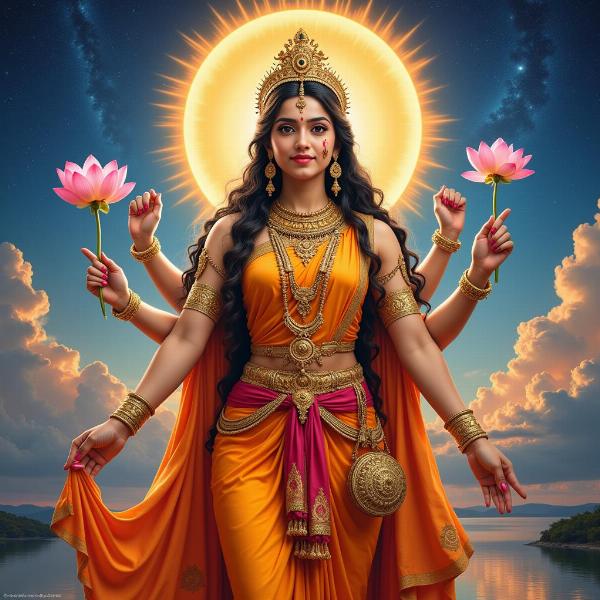Lord Shiva daughter name in Hindi often sparks curiosity and reverence. While Lord Shiva is widely recognized for his powerful and multifaceted nature, less is known about his daughters. This article delves into the rich tapestry of Hindu mythology to explore the fascinating stories and significance surrounding Lord Shiva’s daughters, providing clarity on their names in Hindi and their roles within the divine pantheon.
Who are Lord Shiva’s Daughters?
Hindu scriptures and regional traditions mention several daughters attributed to Lord Shiva. Understanding these narratives requires acknowledging the fluid nature of mythology and the variations that exist across different interpretations. The most commonly referenced daughters are Ashok Sundari, Jyoti, and Manasa. Each embodies unique qualities and represents different aspects of the divine feminine.
Ashok Sundari: The Daughter of Bliss
Ashok Sundari, whose name literally translates to “beauty without sorrow,” is often associated with joy, prosperity, and fulfillment. Her birth story is intertwined with Parvati’s longing for a daughter and her creation of Ashok Sundari from the Kalpavriksha, the wish-fulfilling tree.
 Ashok Sundari, the divine daughter of Lord Shiva and Parvati
Ashok Sundari, the divine daughter of Lord Shiva and Parvati
Jyoti: The Embodiment of Light
Jyoti, meaning “light” or “flame,” represents knowledge, illumination, and spiritual awakening. Her presence signifies the dispelling of ignorance and the triumph of wisdom. She is often depicted as radiant and luminous, symbolizing the divine spark within all beings.
Manasa: The Serpent Goddess
Manasa, revered as the serpent goddess, is associated with fertility, prosperity, and protection from snakebites. She holds a significant place in Bengali folklore and is often depicted with serpents adorning her. Her story is filled with trials and tribulations, reflecting the complexities of human life and the power of devotion.
Lord Shiva Daughter Names and their Significance
The names of Lord Shiva’s daughters hold profound meaning, reflecting their unique attributes and roles within Hindu mythology. Understanding these names provides insights into the diverse facets of the divine feminine as represented by these goddesses.
Ashok Sundari: असोक सुंदरी (asok sundarī)
This name signifies beauty without sorrow, reflecting the joy and prosperity she embodies.
Jyoti: ज्योति (jyoti)
This simple yet powerful name, meaning “light,” encapsulates her association with knowledge and illumination.
Manasa: मनसा (manasā)
This name connects her to the mind and desires, reflecting her association with fertility and prosperity.
The Role of Lord Shiva’s Daughters in Hindu Mythology
Lord Shiva’s daughters, though less prominent than some other deities, play important roles in various narratives and regional traditions. They represent different aspects of the divine feminine, contributing to the rich tapestry of Hindu mythology. Their stories offer valuable lessons about resilience, devotion, and the power of feminine energy.
Conclusion: Embracing the Divine Feminine
Understanding the names and stories of Lord Shiva’s daughters provides a glimpse into the complex and fascinating world of Hindu mythology. These goddesses embody various aspects of the divine feminine, enriching our understanding of the divine pantheon. Exploring their narratives allows us to appreciate the diverse expressions of divinity and the profound significance of feminine energy within the Hindu tradition. Lord Shiva daughter name in Hindi, therefore, offers more than just a name; it opens a window into the richness of cultural and spiritual beliefs.
FAQs:
- Are there other daughters of Lord Shiva mentioned in different texts? Yes, some regional traditions and lesser-known texts mention other daughters attributed to Lord Shiva. However, Ashok Sundari, Jyoti, and Manasa are the most commonly referenced.
- What is the significance of Ashok Sundari’s birth story? Her birth story highlights the power of a mother’s love and the desire for a child. It also showcases the magical properties of the Kalpavriksha.
- Why is Manasa worshipped as a serpent goddess? Manasa’s association with serpents symbolizes her power over nature and her ability to protect from snakebites. She is particularly revered in regions where snakes are prevalent.
- What can we learn from the stories of Lord Shiva’s daughters? Their stories teach us about resilience, devotion, and the importance of embracing both the joys and challenges of life.
- Where can I find more information about these goddesses? Various books, articles, and online resources dedicated to Hindu mythology provide deeper insights into the stories and significance of Lord Shiva’s daughters.
- How are Lord Shiva’s daughters typically depicted in art? They are often portrayed with unique attributes reflecting their individual qualities. Ashok Sundari is depicted as beautiful and serene, Jyoti as radiant and luminous, and Manasa adorned with serpents.
- What is the importance of understanding the feminine aspect of divinity? Recognizing and honoring the feminine aspect of divinity allows for a more complete understanding of the divine and its various manifestations.
Meaning-Hindi.in, a leading Hindi translation service, offers expert translation and localization services for businesses, individuals, and academic institutions. We specialize in various domains, including business and commerce, legal, technical, website localization, and educational materials. Our team of expert linguists ensures accurate and culturally sensitive translations, bridging language barriers and fostering effective communication. Whether you need document translation, website localization, or interpretation services, Meaning-Hindi.in can provide tailored solutions to meet your specific needs. Contact us today for a free consultation at [email protected] or call us at +91 11-4502-7584. Let Meaning-Hindi.in be your trusted partner for all your Hindi translation needs.